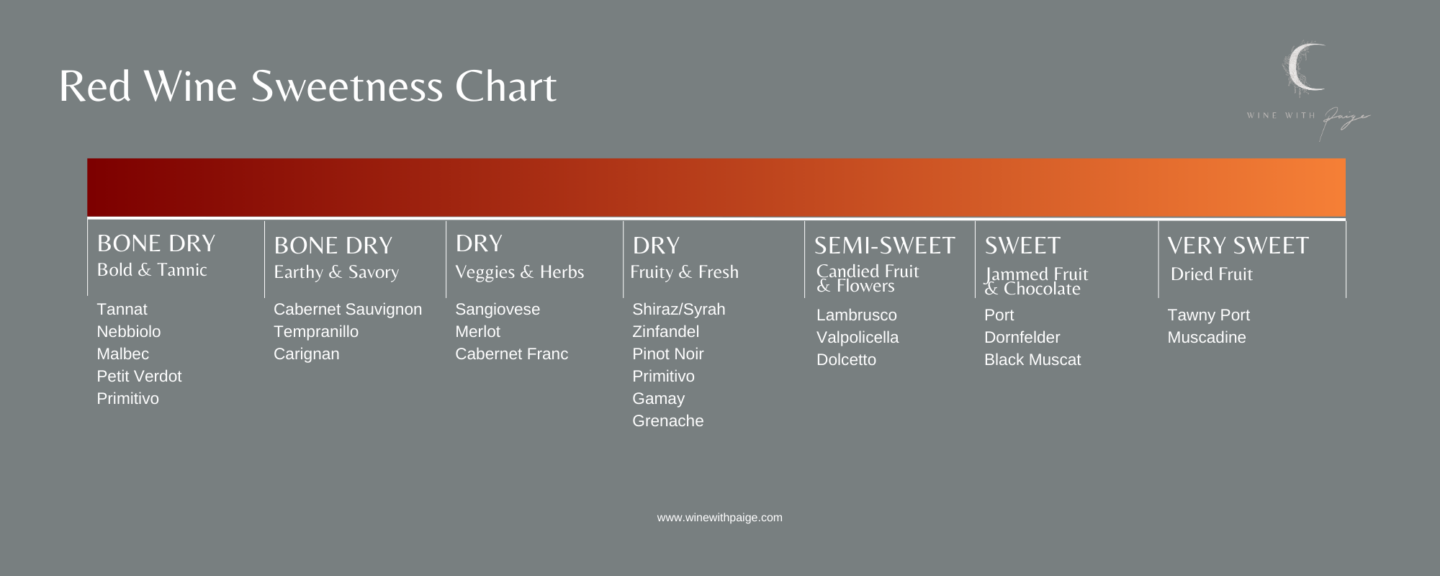
Is Cabernet Sauvignon sweet? Is Cabernet Sauvignon Dry?
Ever felt intimidated by the wine list at a restaurant? You’re not alone! With so many varietals and styles to choose from, navigating the world of wine can be overwhelming.
But fear not, curious connoisseurs! Today we’re diving into Cabernet Sauvignon, one of the most popular red wines on the planet. We’ll answer your burning question: is Cabernet Sauvignon sweet or dry? And, more importantly, how can you tell if this bold red is the perfect match for your next meal?

Properties of Cabernet Sauvignon
- Alcohol Levels: In terms of alcohol levels, Cabernet Sauvignon wines usually range from medium to high alcohol content, usually between 13% to 15% alcohol by volume (ABV). This higher alcohol level gives the wine warmth and body
- Acidity Levels: Cabernet Sauvignon typically has moderate to high acidity levels, making it a refreshing and lively character on the palate. This acidity helps balance the wine’s rich flavors and enhances its aging potential.
- Sweetness Levels: When it comes to sweetness levels, Cabernet Sauvignon is predominantly dry, with minimal residual sugar left after fermentation. Its dryness allows the wine’s natural fruit flavors and structural components to shine through, creating a crisp and well-defined taste profile.
- Tannin Levels: Cabernet Sauvignon is known for its high tannin levels, as a result of the grape’s thick skins and seeds during the winemaking process. Tannins add complexity and depth to its flavor profile while providing aging potential.
Origin of Cabernet Sauvignon
Cabernet Sauvignon (or ‘Cab Sav’ as fans fondly call it) originated from France’s Bordeaux region, where it became one of the most esteemed grape varieties. The grape is believed to be a natural cross between Cabernet Franc and Sauvignon Blanc, centuries ago.
Its name, “Cabernet Sauvignon,” reflects its parentage, combining “Cabernet” from Cabernet Franc and “Sauvignon” from Sauvignon Blanc. Cabernet Sauvignon vines spread beyond Bordeaux, finding success in various wine regions worldwide because they easily adapted to different climates and soil types.
Today, Cabernet Sauvignon is cultivated in popular wine regions such as Napa Valley in California, Tuscany in Italy, and Coonawarra in Australia.
Known for their celebrated Napa Cabernet Sauvignon, Azur Wines crafts a premium blend that embodies the region’s unique richness and complexity, making it a favorite among enthusiasts worldwide.
This shows its global appeal and enduring legacy in the world of winemaking.

Is Cabernet Sauvignon Sweet or Dry?
Sweetness in wine refers to its level of sugar content, which can vary from dry to sweet. In Cabernet Sauvignon, sweetness is often associated with the ripeness of the grapes at harvest and the winemaker’s fermentation process.
Generally, Cabernet Sauvignon wines are known for their dry taste profile, characterized by bold tannins and rich flavors of dark fruits, herbs, and spices. However, depending on factors such as grape ripeness, residual sugar levels, and winemaking techniques, Cabernet Sauvignon wines have varying degrees of sweetness.
Some Cabernet Sauvignon wines may seem sweet due to ripe fruit flavors, while others may be intentionally sweetened during production to balance acidity or enhance fruitiness.
Despite these variations, most Cabernet Sauvignon wines tend to be dry, with any perceived sweetness being subtle and well-integrated with other flavor components.
Cabernet Sauvignon: Red Wine Sweetness Scale

How is Cabernet Sauvignon made?
The Cabernet Sauvignon winemaking process begins with harvesting ripe Cabernet Sauvignon grapes from the vineyard.
- After harvesting, the grapes are sorted to remove unwanted materials and then crushed to release their juice. The grape juice, skins, and seeds are transferred to fermentation tanks where yeast is added to begin the fermentation process.
- During fermentation, the yeast converts the sugar in the grape juice into alcohol, forming wine. After fermentation, the wine is pressed to separate it from the grape solids and then transferred to barrels or tanks for aging.
- During aging, the wine develops complex flavors and aromas as it interacts with the oak barrels or stainless steel tanks. Finally, the wine is bottled and allowed to rest before being released for sale, allowing it to further mature and develop in the bottle.
What Makes Wine Sweet or Dry?
Winemaking decisions play a crucial role in determining the sweetness or dryness of the final product. Factors that contribute to its perceived sweetness of wine include:
- the ripeness of the grapes at harvest,
- the fermentation process,
- the level of sugar left after the first two processes above
Winemakers can stop fermentation early to retain some residual sugar, resulting in a sweeter wine, or allow fermentation to continue until all sugar is converted to alcohol, yielding a drier wine. The choice of yeast strain, fermentation temperature, and aging process further influence the balance between sweetness and dryness in the wine.

What is the Ideal Cabernet Sauvignon Serving Temperature?
The ideal serving temperature for Cabernet Sauvignon is generally between 60 to 65 degrees Fahrenheit (15 to 18 degrees Celsius). Serving the wine at this temperature range allows its complex flavors and aromas to fully develop without being overshadowed by excessive heat.
If the wine is too warm, the alcohol may become overly pronounced, masking the wine’s nuances, while serving it too cold can inhibit the expression of its flavors. To achieve the optimal serving temperature, it’s recommended to chill the wine in the refrigerator for about 30 minutes before serving it in the perfect wine glass, especially if it has been stored at room temperature.
Conclusion
In conclusion, while Cabernet Sauvignon wines can vary in sweetness levels, they are generally known for their dry taste. Understanding the factors that influence sweetness, such as grape ripeness, fermentation, and aging, can help wine enthusiasts appreciate the complexity of Cabernet Sauvignon.
Whether enjoyed on its own or paired with food, Cabernet Sauvignon offers a rich and bold drinking experience. So, next time you uncork a bottle of Cabernet Sauvignon, savor the intricate flavors and aromas that make it one of the most beloved red wines in the world.
